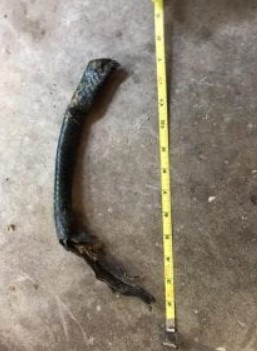By Christine Gelley
The stomach is a fascinating part of the body, regardless of what species you study.
Digestion is an active and noisy process, from chewing, to swallowing, to breakdown, absorption, and disposal. People tend to associate the idea of a “churning stomach” with an illness, but really, the stomach should be churning (well, moving) to do its job. If it is not, you could be in trouble and experiencing a bowl obstruction.
Humans can tell that something is definitely wrong if they have a bowl obstruction. Within a couple days, the inflicted person will be completely miserable and perplexed, leading them to seek aide from a medical doctor if this occurs. Symptoms include bloating, diarrhea, vomiting, dehydration, and general physical weakness as a result.
Babies and animals are less descriptive when experiencing digestive stress. Observant parents (of human or animal offspring) may not know what is wrong, but should be in tuned enough to realize the situation is not good and seek assistance before symptoms of malnutrition or abdominal tissue death occurs.
Unfortunately, due to the inability to speak coherently, animals that have a digestive obstruction may waste away before the mystery of why is solved. Managers will notice that the animal is behaving oddly. They will go off feed, have watery stool, and gradually lose body condition, but rarely show signs of an infection.
Ultrasounds may reveal the issue, but not always. Contents of the digestive tract can be difficult to distinguish on an ultrasound, depending on the material. Metal objects (which can cause hardware disease) or intestinal twisting may be obvious, but contaminants like plastic or Styrofoam are less so. On an ultrasound, plastic and Styrofoam may appear to be plant material in the rumen.

Sheets of plastic (large or small) will float on top of the rumen fiber mat and could block the healthy movement of gases through either end of the animal, thus causing bloat. If many pieces of plastic are ingested, the warmth of the rumen can bind the small particles into dense masses that can block further passage into the intestines and cause malnutrition. They can become lodged in the esophagus during regurgitation and cause suffocation. Alternatively, the plastic could remain in the rumen, getting tangled up with plant material, and taking up space in the rumen, causing decreased intake. In the case of the latter, the animal’s demise can progress very slowly and go undetected until natural death or processing.
Any farm manager could find themselves confronted with this scenario.
Accidental bale wrap ingestion is a contributor to these conditions, which can be referred to as “plastic disease”. Biodegradable sisal twine stands a better chance of passing through the digestive tract, although it can become tangled with plant fiber as well.
In general, bale wrap (plastic net wrap or solid wrap for baleage) is an excellent tool to improve hay storage and preserve quality, but efforts must be made to prevent accidental ingestion during feeding. Before grinding hay for a mixed feed or presenting the bales to the animals, remove all the wrap from the bale. This can be increasingly difficult in the winter and on frozen baleage, but a careful eye and persistent management can go a long way to reduce these problems.
Litter is another issue.
The Ohio Department of Transportation estimates that annual roadside litter in our state totals nearly twelve tons and costs about $10 million dollars to address. Along with being unsightly, this litter may be accidently ingested by many kinds of animals, including livestock if it is baled in hay. Scout your field for litter before mowing hay, flag bales you suspect may contain trash, and/or unroll bales to increase your chances of finding the garbage before your animals do.
Littering is a crime in the State of Ohio. If you witness littering, you can report the offense to the Ohio Department of Transportation online at www.dot.state.oh.us. Law enforcement officers including police officers, state patrol, and wildlife officers can issue tickets to litterers. Report your location, a description of the occurrence, and the license plate of the offender if you can.
Under Ohio law, litter is “any trash thrown, discarded or dropped by a person onto public property, private property not owned by the individual, or into Ohio’s waterways. The Ohio Revised Code prohibits littering, regardless of whether or not it was intentional. Numerous laws prohibit littering and illegal dumping. Littering is a serious offense, punishable by fines of up to $500 and 60 days in jail.” More details about litter prevention can be found at www.keepohiobeautiful.org.
The convenience of disposable, non-biodegradable packaging our modern lives comes with a cost. Responsible use of this packaging is important for human, animal, and environmental health. My advice to you is take caution to prevent accidental ingestion of waste, know the signs of plastic and hardware disease, and share your story with your community to raise awareness about the negative impacts of littering.
Source : osu.edu